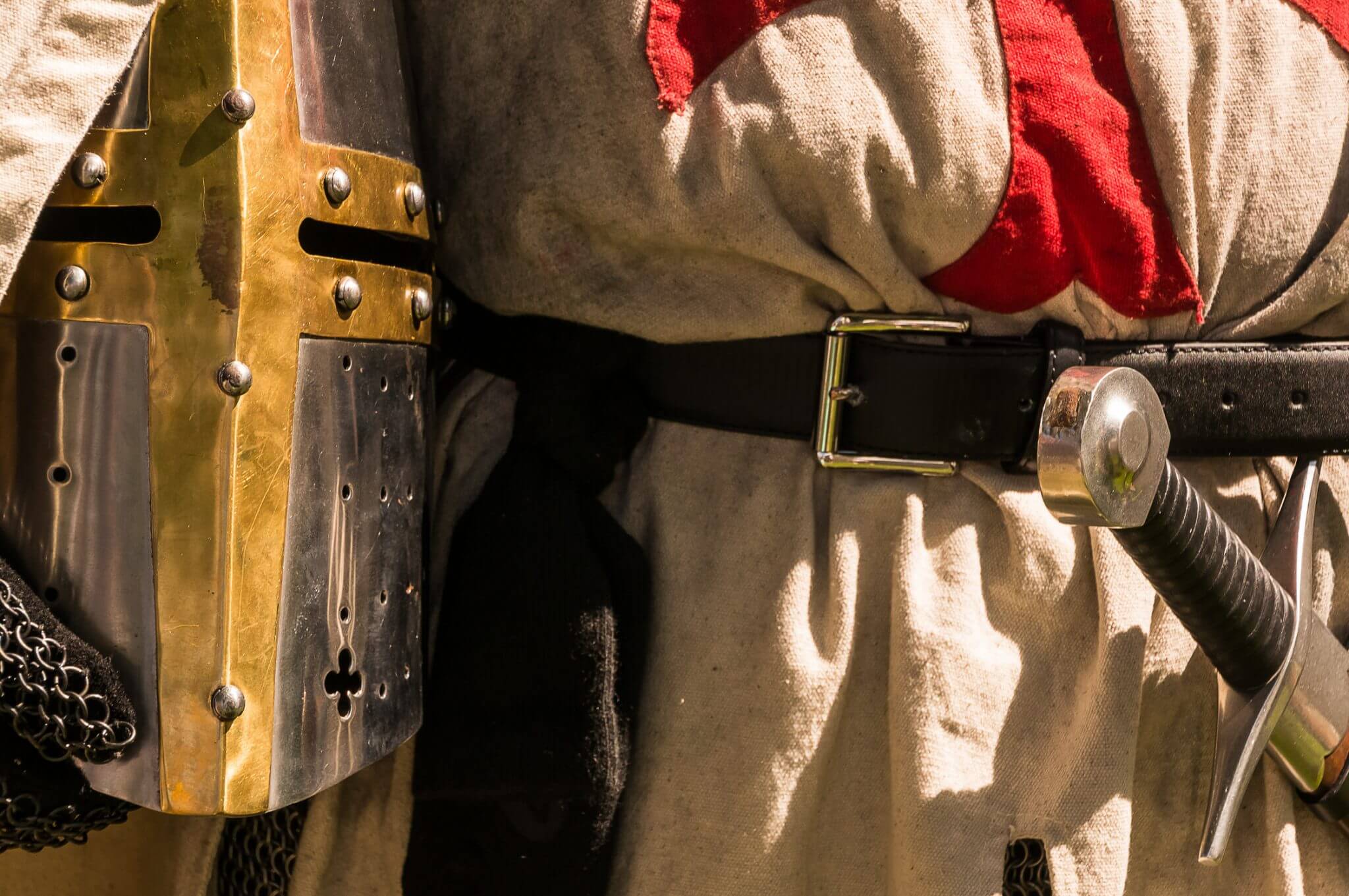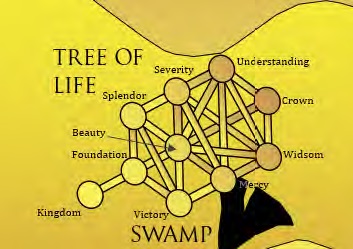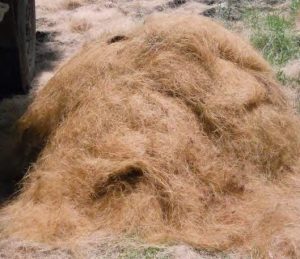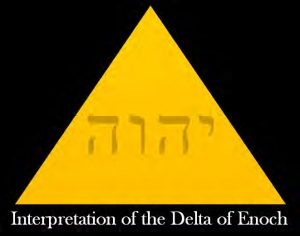The Curse of Oak Island- Season 5, Episode 14: The Templar Connection

The following is a Plot Summary and Analysis of Season 5, Episode 14 of the History Channel’s TV series The Curse of Oak Island.
.
.
[SPOILER ALERT!!!]
.
.
Plot Summary
The episode begins with a flashback to Rick Lagina and Gary’s Drayton’s discovery of the lead cross in Season 5, Episode 10. The narrator reminds us of the cross’ resemblance to a Templar carving on one of the walls of Domme prison, and suggests that its presence on Oak Island “could bring into question the very history of North America.”

 The narrator- with the help of Theology professor Amir Hussain, author Clive Prince, author Sanford Holst, author Kathleen McGowan Coppens (who appeared in Season 2, Episodes 6 and 7 of The Curse of Oak Island), author James Wasserman, curator Jonathan Young, researcher David Whitehead, writer Christopher Knight, author Jerry Glover (who appeared in Season 5, Episode 9), academic Evan Pritchard, author Lynn Picknett, and researcher Paul Troutman (who appeared in Season 2, Episode 2)- proceeds to lecture us on the history of the Knights Templar. After briefing us on the Order’s founding following the First Crusade, he reminds us of the theory that Templars secretly conducted excavations beneath the Al-Aqsa Mosque, their first permanent headquarters. Legend has it that beneath the mosque, the Templars discovered priceless religious artifacts from the First Temple of Solomon, including the Ark of the Covenant and the golden Menorah.
The narrator- with the help of Theology professor Amir Hussain, author Clive Prince, author Sanford Holst, author Kathleen McGowan Coppens (who appeared in Season 2, Episodes 6 and 7 of The Curse of Oak Island), author James Wasserman, curator Jonathan Young, researcher David Whitehead, writer Christopher Knight, author Jerry Glover (who appeared in Season 5, Episode 9), academic Evan Pritchard, author Lynn Picknett, and researcher Paul Troutman (who appeared in Season 2, Episode 2)- proceeds to lecture us on the history of the Knights Templar. After briefing us on the Order’s founding following the First Crusade, he reminds us of the theory that Templars secretly conducted excavations beneath the Al-Aqsa Mosque, their first permanent headquarters. Legend has it that beneath the mosque, the Templars discovered priceless religious artifacts from the First Temple of Solomon, including the Ark of the Covenant and the golden Menorah.

 The narrator goes on to explain how the Templars grew and expanded their influence throughout the 12th and 13th Centuries by developing Europe’s first banks. He then describes how the Knights Templar were accused of heresy and disbanded in 1307, and how some of their number are rumoured to have escaped from France to Scotland with their most precious treasures during this time. He further explains how some theorists believe these outlawed Templar knights travelled from Scotland to the New World with the aid of Scottish-Orcadian nobleman Henry Sinclair and Italian mariners Nicolo and and Antonio Zeno and possibly buried their treasures on Oak Island.
The narrator goes on to explain how the Templars grew and expanded their influence throughout the 12th and 13th Centuries by developing Europe’s first banks. He then describes how the Knights Templar were accused of heresy and disbanded in 1307, and how some of their number are rumoured to have escaped from France to Scotland with their most precious treasures during this time. He further explains how some theorists believe these outlawed Templar knights travelled from Scotland to the New World with the aid of Scottish-Orcadian nobleman Henry Sinclair and Italian mariners Nicolo and and Antonio Zeno and possibly buried their treasures on Oak Island.
We then see old footage from Season 4, Episode 12, in which Rick Lagina and Doug Crowell travelled to Roslyn, New York, to visit with researcher Zena Halpern and discuss her maps, first introduced in the premiere of Season 4. The narrator reminds us that Halpern believes that a 12th Century English Crusader named Ralph de Sudeley buried Templar treasure on Oak Island.
Next, the narrator reminds us that, prior to visiting Zena Halpern, Rick Lagina and Doug Crowell, along with Charles Barkhouse, met with researchers Alessandra Nadudvari and Tim Loncarich in New Ross, Nova Scotia in Season 4, Episodes 1 and 2. There, Nadudvari and Loncarich showed the treasure hunters a stone which they believed bore a faded cross pattee, a style of cross used by the Knights Templar.


We are then reminded of how researcher Terry Deveau introduced the Oak Island crew to the Overton Stone in Season 3, Episode 4, on which is carved what Marty Lagina suggested is a “Templar cross.” Deveau speculated that the carving might have served to commemorate a friendship treaty between a group of Europeans and a band of local Mi’kmaq Indians. Doug Crowell, in an interview, then expounds the theory that the Mi’kmaq cultural hero Glooscap is based on Henry Sinclair- a theory bolstered by researcher Mark Finnan’s claim that the flag of the Mi’kmaq Nation is the mirror image of one of the battle standards flown by the Knights Templar.


Next, the narrator raises the question of whether or not an outlawed band of Templar Knights could possibly have had the ability to create complex underground structures like the Money Pit and the Smith’s Cove Flood Tunnel. He then reminds us of the coconut fibres which Dan Henskee, Jack Begley, Alex Lagina, and Peter Fornetti unearthed on Smith’s Cove in Season 1, Episode 2. These fibres were carbon dated to between 1260 and 1400 A.D.- a period of time consistent with the Knights Templar theory.
After that, the narrator reminds us of the peculiar Domme Cross carved by incarcerated Templar Knights on one of the walls of Domme prison, which Jerry Glover suggested might have been inspired by the Kabbalistic Tree of Life- a symbol which researcher Petter Amundsen, back in Season 1, Episode 4, suggested was manifest in Nolan’s Cross.

 Next, the narrator reminds us that, historically, an unusual number of Oak Island treasure hunters have been Freemasons. He then describes the theory that Freemasonic fraternities are descended from the aforementioned band of outlawed Templar knights, and reminds us of the Oak Island crew’s visit to Rosslyn Chapel- a building containing carvings which some believe indicate a connection between Freemasonry and the Knights Templar- in Season 2, Episode 7. The narrator then summarizes the theory, put forth by writer Alan Butler in the same episode, that the Money Pit bears resemblance to the Freemasonic legend of the Royal Arch of Enoch.
Next, the narrator reminds us that, historically, an unusual number of Oak Island treasure hunters have been Freemasons. He then describes the theory that Freemasonic fraternities are descended from the aforementioned band of outlawed Templar knights, and reminds us of the Oak Island crew’s visit to Rosslyn Chapel- a building containing carvings which some believe indicate a connection between Freemasonry and the Knights Templar- in Season 2, Episode 7. The narrator then summarizes the theory, put forth by writer Alan Butler in the same episode, that the Money Pit bears resemblance to the Freemasonic legend of the Royal Arch of Enoch.
Analysis
Coconut Fibre
 Back in Season 1, Episode 2, while digging on Smith’s Cove, Dan Henskee, Jack Begley, Alex Lagina, and Peter Fornetti unearthed what appeared to be coconut fibre. Testing affirmed that the substance was indeed coconut fibre, and that it was carbon dated to between 1260 and 1400 A.D. Oak Island Tours Inc. is one in a long line of treasure hunting syndicates to uncover coconut fibre on Oak Island. It was discovered in 1804 in the Money Pit by the Onslow Company, in 1850 in Smith’s Cove by the Truro Company, in 1866 by the Halifax Company, in 1936 by Gilbert Hedden, in the 1960’s by Robert and Bobby Restall and Robert Dunfield, and on several occasions throughout the past 40 years by Dan Blankenship, Dave Blankenship, and Dan Henskee of Triton Alliance. It is interesting to note that, at the time of the Money Pit’s discovery in 1795, the nearest coconut palms grew in the Caribbean islands 1,500 miles southeast of Oak Island, and that throughout the 16th and 17th Centuries, coconut fibre was commonly used as caulking on sailing ships.
Back in Season 1, Episode 2, while digging on Smith’s Cove, Dan Henskee, Jack Begley, Alex Lagina, and Peter Fornetti unearthed what appeared to be coconut fibre. Testing affirmed that the substance was indeed coconut fibre, and that it was carbon dated to between 1260 and 1400 A.D. Oak Island Tours Inc. is one in a long line of treasure hunting syndicates to uncover coconut fibre on Oak Island. It was discovered in 1804 in the Money Pit by the Onslow Company, in 1850 in Smith’s Cove by the Truro Company, in 1866 by the Halifax Company, in 1936 by Gilbert Hedden, in the 1960’s by Robert and Bobby Restall and Robert Dunfield, and on several occasions throughout the past 40 years by Dan Blankenship, Dave Blankenship, and Dan Henskee of Triton Alliance. It is interesting to note that, at the time of the Money Pit’s discovery in 1795, the nearest coconut palms grew in the Caribbean islands 1,500 miles southeast of Oak Island, and that throughout the 16th and 17th Centuries, coconut fibre was commonly used as caulking on sailing ships.
 The Smith’s Cove coconut fibre’s carbon date of 1260-1400 A.D. is particularly baffling. Botanists and Age of Discovery historians alike agree that coconut fibre is neither endemic to Nova Scotia nor to the New World. In fact, coconut is native to Southeast Asia and the Indian Ocean; today, all coconuts can trace their genetic origins to these two regions. Throughout the latter half of the 1400’s, the Portuguese transported coconuts from the Indian Ocean to their newly-established plantation colonies on the western coasts of Africa. Following Columbus’ discovery of the New World in 1492, Portuguese explorers introduced coconuts from their West African colonies to South America and the Caribbean, where they thrived.
The Smith’s Cove coconut fibre’s carbon date of 1260-1400 A.D. is particularly baffling. Botanists and Age of Discovery historians alike agree that coconut fibre is neither endemic to Nova Scotia nor to the New World. In fact, coconut is native to Southeast Asia and the Indian Ocean; today, all coconuts can trace their genetic origins to these two regions. Throughout the latter half of the 1400’s, the Portuguese transported coconuts from the Indian Ocean to their newly-established plantation colonies on the western coasts of Africa. Following Columbus’ discovery of the New World in 1492, Portuguese explorers introduced coconuts from their West African colonies to South America and the Caribbean, where they thrived.

 If popular mainstream history is to be believed, coconuts (and, presumably, coconut components, including coconut fibres) were not introduced to the New World until the late 1490’s, at the very earliest. Assuming that the coconut fibre on Smith’s Cove was interred relatively shortly (i.e. less than 90+ years) after being harvested from the shell, its carbon dating of 1260-1400 A.D. apparently contradicts this notion, giving rise to a whole new realm of strange and intriguing possibilities. Perhaps early Portuguese, Spanish, or Italian explorers obtained large quantities of coconut fibre decades before Henry the Navigator’s (an administrator of the 15th Century Portuguese Empire who set in motion the Age of Discovery) discovery of the West African coast (the site of the earliest Portuguese coconut plantations) in the mid- 1400’s, and made some long-forgotten or undocumented voyage to the New World a century or more before Christopher Columbus’ 1492 discovery of the Americas. It is certainly possible that 13th, 14th, and 15th Century Europeans might have have obtained Indian or even Southeast Asian coconut fibre via the Silk Road, an ancient series of trade routes bridging Europe, Arabia, India, and China (although one wonders why 13th, 14th, or early 15th Century Europeans would use mass quantities of such an exotic commodity to construct a giant filter, as appears to be the case on Smith’s Cove). Alternatively, perhaps the Knights Templar, following their suppression in 1307, somehow managed to procure large quantities of Indian coconut fibre before shipping their fabled treasure across the Atlantic; after all, Palestine, once the heart of Templar territory, lies at an important Silk Road junction. Or, is it possible that another group of people with access to large quantities of 13 to early 15th Century coconut fibre, perhaps even a group not typically associated with Oak Island (ex. members of some medieval Indian or Southeast Asian dynasty), made a secret voyage to Oak Island during the Middle Ages?
If popular mainstream history is to be believed, coconuts (and, presumably, coconut components, including coconut fibres) were not introduced to the New World until the late 1490’s, at the very earliest. Assuming that the coconut fibre on Smith’s Cove was interred relatively shortly (i.e. less than 90+ years) after being harvested from the shell, its carbon dating of 1260-1400 A.D. apparently contradicts this notion, giving rise to a whole new realm of strange and intriguing possibilities. Perhaps early Portuguese, Spanish, or Italian explorers obtained large quantities of coconut fibre decades before Henry the Navigator’s (an administrator of the 15th Century Portuguese Empire who set in motion the Age of Discovery) discovery of the West African coast (the site of the earliest Portuguese coconut plantations) in the mid- 1400’s, and made some long-forgotten or undocumented voyage to the New World a century or more before Christopher Columbus’ 1492 discovery of the Americas. It is certainly possible that 13th, 14th, and 15th Century Europeans might have have obtained Indian or even Southeast Asian coconut fibre via the Silk Road, an ancient series of trade routes bridging Europe, Arabia, India, and China (although one wonders why 13th, 14th, or early 15th Century Europeans would use mass quantities of such an exotic commodity to construct a giant filter, as appears to be the case on Smith’s Cove). Alternatively, perhaps the Knights Templar, following their suppression in 1307, somehow managed to procure large quantities of Indian coconut fibre before shipping their fabled treasure across the Atlantic; after all, Palestine, once the heart of Templar territory, lies at an important Silk Road junction. Or, is it possible that another group of people with access to large quantities of 13 to early 15th Century coconut fibre, perhaps even a group not typically associated with Oak Island (ex. members of some medieval Indian or Southeast Asian dynasty), made a secret voyage to Oak Island during the Middle Ages?


The Royal Arch of Enoch
 According to Masonic teachings, one of the most valuable treasures of the Temple of Solomon, and subsequently of the Knights Templar, is a golden triangle called the Delta of Enoch, on which is inscribed the ineffable Name of God.
According to Masonic teachings, one of the most valuable treasures of the Temple of Solomon, and subsequently of the Knights Templar, is a golden triangle called the Delta of Enoch, on which is inscribed the ineffable Name of God.
According to the Book of Genesis, Enoch was a virtuous man beloved by God. The Old Testament asserts that he was the great-grandfather of Noah, the man who built the legendary Ark which housed Noah himself, his wife, his three sons, his three daughters-in-law, and mating pairs of all the world’s animals during the Great Flood.
According to Jewish and Masonic legend, Enoch had a dream in which  God revealed His true Name to him on a mountaintop and forbade him to repeat it to anyone. Then, God transported him underground, through nine arches, to a subterranean vault where he found the Name of God engraved on a triangular plate of solid gold. When he awoke, Enoch interpreted his dream as a sign to construct the chambers he had seen. He immediately set about excavating the first eight subterranean chambers, which were meant for protection, underneath a mountain called Mount Moriah. In the ninth and final chamber, he built a pedestal and placed upon it a triangle of pure gold on which was written the unutterable Name of God (in his dream, Enoch had not only heard the Name of God but also seen it written in the clouds). When he had completed the chambers, Enoch marked the place where they were buried with a crude temple, which he built from unhewn stones.
God revealed His true Name to him on a mountaintop and forbade him to repeat it to anyone. Then, God transported him underground, through nine arches, to a subterranean vault where he found the Name of God engraved on a triangular plate of solid gold. When he awoke, Enoch interpreted his dream as a sign to construct the chambers he had seen. He immediately set about excavating the first eight subterranean chambers, which were meant for protection, underneath a mountain called Mount Moriah. In the ninth and final chamber, he built a pedestal and placed upon it a triangle of pure gold on which was written the unutterable Name of God (in his dream, Enoch had not only heard the Name of God but also seen it written in the clouds). When he had completed the chambers, Enoch marked the place where they were buried with a crude temple, which he built from unhewn stones.
Mount Moriah- the anglicized interpretation of the ancient Hebrew name Har HaBayit- was the holy mountain where, generations after Enoch and his son Noah, Abraham prepared an altar on which to sacrifice his son Isaac. According to the Book of Genesis, God, in order to test Abraham’s loyalty, commanded him to offer up his son Isaac as a sacrifice. Abraham conceded to God’s demand and set about preparing an altar on Mount Moriah. When that was done, he led Isaac to the mountaintop, bound him to the altar, and prepared to slaughter him. However, his hand was stayed at the last moment by an angel, who informed him that the whole scenario was a test of loyalty. At that moment, Abraham spotted a ram which had caught its horns in some nearby bushes and, out of gratitude to God, sacrificed it on the altar instead of his son.

 Centuries later, a Jebusite (i.e. Canaanite tribesman) named Araunah built a threshing floor on Mount Moriah. A threshing floor is a stone floor on which grain is trampled underfoot in order to separate the stalks from the husks. King David, the second king of the United Kingdom of Israel, purchased this threshing floor from Araunah and converted it into an altar. Later, David’s son Solomon constructed his famous First Temple of Jerusalem on the site of the altar. While Solomon’s builders were constructing the Temple foundation, they discovered the Enochean chambers and the Delta of Enoch. When the Temple was completed, the Delta was placed in its treasury.
Centuries later, a Jebusite (i.e. Canaanite tribesman) named Araunah built a threshing floor on Mount Moriah. A threshing floor is a stone floor on which grain is trampled underfoot in order to separate the stalks from the husks. King David, the second king of the United Kingdom of Israel, purchased this threshing floor from Araunah and converted it into an altar. Later, David’s son Solomon constructed his famous First Temple of Jerusalem on the site of the altar. While Solomon’s builders were constructing the Temple foundation, they discovered the Enochean chambers and the Delta of Enoch. When the Temple was completed, the Delta was placed in its treasury.
Legend has it that, eleven thousand years later, in the aftermath of the First Crusade, the Delta of Enoch was recovered by the Knights Templar. More than two hundred years after that, it was brought to Oak Island and buried in the Money Pit. The men who constructed the Money Pit build nine oak platforms within it, representing the nine levels of the Royal Arch of Enoch.
Want to Help?
If you enjoyed this article and would like to help support this website, please check out our online bookshop:







Analice
Thank you for your blog post.Really thank you! Awesome.
A. Nadudvari
Thank you for spelling my name right. 🙂
Hammerson Peters
You’re welcome!